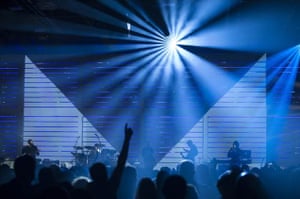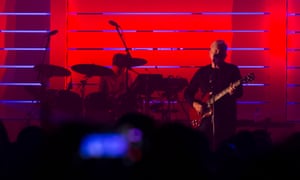New Order + Liam Gillick: So It Goes review – a suitably theatrical Manchester return | Music
The old Granada studios building has enormous significance in the story of Joy Division and New Order. In 1978, the former made their television debut here on Tony Wilson’s So It Goes programme after singer Ian Curtis berated the presenter in Manchester’s Rafters nightclub. “You bastard!†he began. “You put the Sex Pistols and Buzzcocks and Magazine and all those others on the telly, what about us?†Three years later, when the bandmates had regrouped as New Order after Curtis’s suicide, a Granada studio again broadcast their musical baby steps, this time on the short-lived Celebration.
On those occasions, both bands were at the start of something. Today’s New Order have it all behind them in the form of one of the most illustrious back catalogues in pop and a trademark sound that has become hugely influential, although they are still looking for ways to explore and reinvent it.
Hence this first of five Manchester international festival keynote shows, also called So It Goes â€" which have the rather arty, very Factory Records subtitle âˆ'(No,12k,Lg,17Mif) and pair the band with a 12-piece synthesiser orchestra from the Royal Northern College Of Music and a “responsive†stage set designed by visual artist Liam Gillick.
Beforehand, 61-year old singer Bernard Sumner promised a set list full of surprises (“Requests for Blue Monday will fall on deaf ears, and these days these ears are pretty deafâ€) and proves as good as his word. The gig even begins without the band on stage. Instead, a conductor directs synthesiser players situated on two rows of boxes, behind huge Venetian blinds, as they perform a more symphonic rendition of 1985’s mournful, rarely played Elegia. As the band arrive and the Venetian blinds start opening and closing to the songs, teasing glimpses reveal dancing synth players.
Who’s Joe (from 2005’s so-so Waiting for the Sirens’ Call) probably wouldn’t feature on many fans’ fantasy setlists but has been thrillingly reimagined, with all sorts of new dramatic swoops. Shrieks of delight â€" and a few watery eyes â€" greet Disorder, the opening track from Joy Division’s Unknown Pleasures. It was last performed in 1980, but with new technology recreating and embellishing producer Martin Hannett’s synth squelches and studio wizardry in ways that were impossible live back then, it sounds jawdropping.

Some have interpreted this series of special shows as some sort of tit-for-tat with estranged bassist Peter Hook, whose Haçienda Classical project includes an orchestral reworking of Blue Monday. However, So It Goes is rather different, a continuation of the band’s ongoing marriage of pop with the left-field.
So the likes of Ultraviolence, another tune not played live for over 30 years, are pushed and twisted into new atmospheres; 1989’s Dream Attack starts off relatively faithfully, subtly augmented by orchestral brassy stabs, but eventually bursts into new colour with banks of synthesisers in harmony; Behind Closed Doors and All Day Long are both beautifully reworked, the former with a more eastern feel, as the synth strings bring new drama to songs with (sadly) timeless themes of domestic violence and child abuse respectively.
New Order’s catalogue has enough treasures to sustain a hit-free setlist, although there are dips into the singles discography with the now rarely played Shellshock and Subculture. Bizarre Love Triangle is a regular live favourite, but is beautifully segued into a spectral version of Vanishing Point, from 1989’s Technique. However, this show isn’t just about revisiting old glories. Plastic, from 2015’s return-to-form album, Music Complete, is given a turbocharged symphonic dance arrangement, with a subtle to Donna Summer’s I Feel Love.

A small technical hitch prompts Sumner to refer to the “old days†when the band’s notoriously malfunctioning home-made synths would cause chaos and unintended comedy on stage, but otherwise New Order are as on-point here as they have been as a live act. Keyboardist Gillian Gilbert looks emotional, drummer Stephen Morris is a percussive jack-in-the-box. Sumner is sober and respectfully sombre, gradually loosening up to respond to a bellow for some classic or other (“It’s not that kind of gigâ€) and affectionately teasing Mancunian conductor Joe Duddell (“He looks more like a bus conductorâ€) before a perfect Your Silent Face.
Bassist Tom Chapman plays Hook’s bassline so beautifully mournfully it’s hard not to remember his predecessor’s huge contribution or the many others â€" such as the late Wilson, Hannett, and manager Rob Gretton â€" who were key players in this story but were lost along the way. When Ian Curtis sang the Closer album’s magnificent highlight, Decades, at Joy Division’s final show at Birmingham University, those pesky synthesisers duly misbehaved. It’s taken 37 years and 18 musicians, but surely the spectrally serene electronic-symphonic rendition that closes this concert sounds exactly as he would have wanted.


0 Response to "New Order + Liam Gillick: So It Goes review – a suitably theatrical Manchester return | Music"
Posting Komentar